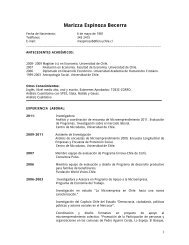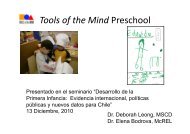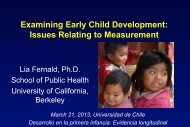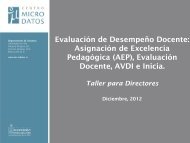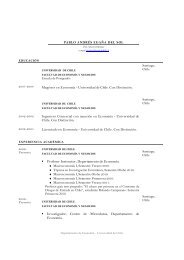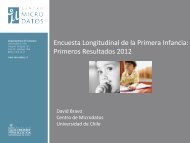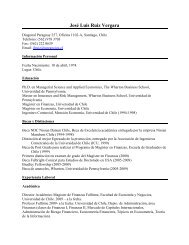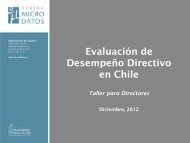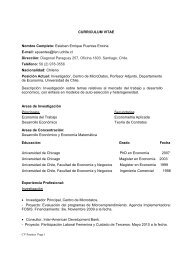Introducción a Series de Tiempo Univariadas - Centro Microdatos
Introducción a Series de Tiempo Univariadas - Centro Microdatos
Introducción a Series de Tiempo Univariadas - Centro Microdatos
Create successful ePaper yourself
Turn your PDF publications into a flip-book with our unique Google optimized e-Paper software.
Introducción a <strong>Series</strong> <strong>de</strong> <strong>Tiempo</strong> <strong>Univariadas</strong>December 31, 2010dfuller imacec, regress drift lags(0)Dickey-Fuller test for unit root Number of obs = 297----------- Z(t) has t-distribution -----------Test 1% Critical 5% Critical 10% CriticalStatistic Value Value Value------------------------------------------------------------------------------Z(t) -1.386 -2.339 -1.650 -1.284------------------------------------------------------------------------------p-value for Z(t) = 0.0835------------------------------------------------------------------------------D.imacec | Coef. Std. Err. t P>|t| [95% Conf. Interval]-------------+----------------------------------------------------------------imacec |L1. | -.0131869 .0095172 -1.39 0.167 -.0319171 .0055434|_cons | 1.422699 .8394634 1.69 0.091 -.2293968 3.074795------------------------------------------------------------------------------dfuller imacec, regress nocon lags(0)Dickey-Fuller test for unit root Number of obs = 297---------- Interpolated Dickey-Fuller ---------Test 1% Critical 5% Critical 10% CriticalStatistic Value Value Value------------------------------------------------------------------------------Z(t) 0.660 -2.580 -1.950 -1.620------------------------------------------------------------------------------D.imacec | Coef. Std. Err. t P>|t| [95% Conf. Interval]-------------+----------------------------------------------------------------imacec |L1. | .002058 .0031184 0.66 0.510 -.004079 .008195------------------------------------------------------------------------------El test <strong>de</strong> Dickey-Fuller original está pensado para un proceso autoregresivo <strong>de</strong> or<strong>de</strong>n superior seutiliza el test Dickey Fuller Aumentado (ADF):La cantidad <strong>de</strong> rezagos a consi<strong>de</strong>rar se pue<strong>de</strong> escoger <strong>de</strong> manera óptima según criterios <strong>de</strong>información.El test <strong>de</strong> Phillips y Perron (1988), bastante popular en series <strong>de</strong> tiempo financieras, difiere <strong>de</strong>ltest ADF en la forma que se consi<strong>de</strong>ra la presencia <strong>de</strong> heterocedasticidad y/o autocorrelación <strong>de</strong>or<strong>de</strong>n superior. En particular el test ADF trata <strong>de</strong> incorporar la cantidad <strong>de</strong> rezagos necesaria paramo<strong>de</strong>lar este comportamiento, el test PP no incorpora rezagos sino que estima el mo<strong>de</strong>loconsi<strong>de</strong>rando la presencia <strong>de</strong> esto en el error.Por ejemplo, para la serie <strong>de</strong>sempleo:70



